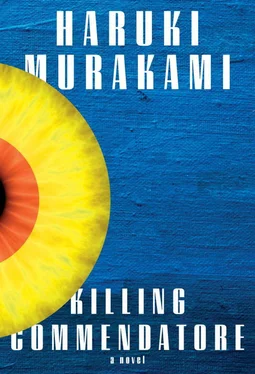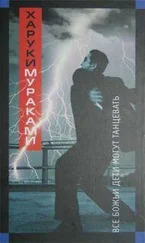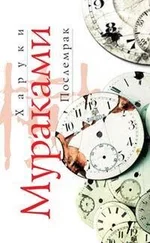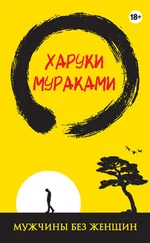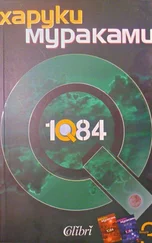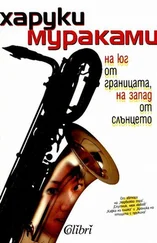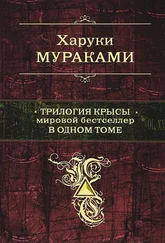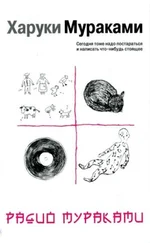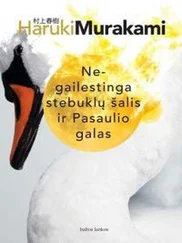I took a sip of coffee and wiped my mouth with a paper napkin. Two crows, cawing at each other, winged their way across the valley, undeterred by the rain. Wet by the rain, their wings would only grow a deeper black.
“I don’t know much about Buddhism,” I said to Menshiki, “so I don’t understand all the details, but doesn’t a priest doing a voluntary burial—this nyujo —mean he chooses to go into a coffin and die?”
“Exactly. Nyujo originally means ‘attaining enlightenment,’ so they have the term ikinyujo —‘living nyujo ’—to distinguish the two. They make a stone-lined underground chamber and insert a bamboo pipe to allow in air. Before a priest does nyujo he maintains a fruitarian diet for a set time so his body won’t putrefy but will become nicely mummified.”
“Fruitarian?”
“Just eating grasses and nuts and berries. They eat no cooked foods whatsoever, starting with grains. In other words, a radical elimination of all fats and moisture from the body. Changing the makeup of the body so it can easily mummify. And after purifying his body, the priest goes underground. In the darkness there the priest fasts and recites sutras, hitting a gong in time to that. Or ringing a bell. And people can hear the sound of that gong or bell through the vent hole. But at some point the sounds stop. That’s the sign that he’s breathed his last. And over a period of time the body gradually turns into a mummy. The custom is to unearth the body after three years and three months.”
“Why would they do that?”
“So the priests could practice austerity to the point of becoming self-mummified. Doing that allows them to reach enlightenment and to arrive at a realm beyond life and death. This also connects up with mankind’s salvation. So-called Nirvana. The unearthed enlightened monk, the mummy, is kept at a temple, and through praying to it people are saved.”
“In reality it’s a kind of suicide.”
Menshiki nodded. “Which is why in the Meiji period the practice of self-burial was outlawed. People who helped in the process could be arrested for aiding and abetting suicide. The truth is, though, priests continued to follow the practice in secret. That’s why there may be quite a few cases of priests being buried but never unearthed by anyone.”
“Are you thinking that stone mound is the remains of a secret burial of that kind?”
Menshiki shook his head. “We won’t know until we actually remove the stones. But it’s possible. There’s no bamboo tube there, but the way it’s constructed, air could get in through the gaps, and you can hear sounds from inside too.”
“And you’re saying that someone is still alive underneath those stones and is ringing a gong or bell every night?”
Menshiki shook his head again. “That obviously doesn’t make any sense.”
“Reaching Nirvana—is that different from merely dying?”
“It is. I’m not all that familiar with Buddhist doctrine, but as far as I understand, Nirvana is found beyond life and death. You could see it as the idea that even if the flesh dies and disappears, the soul goes over to a place beyond life and death. Worldly flesh is nothing more than a temporary dwelling.”
“Even if a priest were, through burial alive, to reach Nirvana, is it possible for him to rejoin his physical body?”
Menshiki said nothing and looked at me for a while. He took a bite of his ham sandwich, and a sip of coffee.
“What you’re saying is—”
“I didn’t hear that sound until four or five days ago,” I said. “I’m certain of that. If the sound had been there I would have noticed. Even if it was small, it’s not the kind of sound I would have missed. I only started hearing it a few days ago. What I mean is, even if there’s somebody underneath those stones, that person hasn’t been ringing the bell for a long time.”
Menshiki returned his coffee cup to the saucer and studied the pattern on the cup. “Have you seen a real mummified priest?” he finally said.
I shook my head.
“I’ve seen several. When I was young I traveled around Yamagata Prefecture on my own and saw a few that were preserved in temples there. For some reason there are a lot of these mummified priests in the Tohoku region, especially in Yamagata. Honestly, they’re not very nice to look at. Maybe it’s my lack of faith, but I didn’t feel very grateful when I saw them. Small, brown, all shriveled up. I probably shouldn’t say this, but the color and texture reminded me of beef jerky. The physical body really is nothing more than a fleeting, empty abode. That, at least, is what these mummies teach us. We may do our utmost, but at best we end up as no more than beef jerky.”
He picked up the ham sandwich he’d been eating and gazed at it intently for a moment. As if he were seeing a ham sandwich for the first time in his life.
He went on. “At any rate, let’s wait till after lunch for them to move those stones. Then we’ll know more, whether we want to or not.”
—
We went back to the site in the woods just after one fifteen. The crew had finished lunch and were hard at work. The two workmen put wedge-like metal implements in the gaps between the stones, and the backhoe used a rope to pull those and raise the stones. The workmen then attached ropes to the dug-up stones, and the shovel hauled these up. It was time consuming, but one by one the stones were steadily unearthed and moved off to the side.
Menshiki and the foreman were deep in conversation about something for a while, but then he came back to join me.
“As they thought, the stones aren’t all that thick. Looks like they’ll be able to remove them,” he explained. “There seems to be a lattice-shaped lid underneath all the stones. They don’t know what it’s made of, but that lid supported the stones. After they remove all the stones on top they’ll need to take off that lid. They don’t know yet if they can. It’s impossible to guess what lies beneath that. It’ll take a while for them to remove all the stones, and once they’ve made more progress they’ll call us, so they said they’d like us to wait in the house. If you don’t mind, let’s do that. Standing around here isn’t going to help.”
We walked back home. I should have used the extra time to continue work on the portrait, but I didn’t feel I’d be able to concentrate on painting. The operation out in the woods had me on edge. The six-foot-square stone flooring that had emerged from underneath the mound of crumbling old stones. The solid lattice lid. And the space that seemed to lie below it. I couldn’t erase these images from my mind. Menshiki was right. Until we settled this matter we wouldn’t be able to move forward on anything else.
“Do you mind if I listen to music while we wait?” Menshiki asked.
“Not at all,” I said. “Play whatever record you’d like. I’ll be in the kitchen preparing some food.”
He chose a recording of Mozart. A sonata for piano and violin. The Tannoy Autograph speakers weren’t very showy, but gave out a deep, steady sound. The perfect speakers for classical music, especially for listening to vinyl records of chamber music. As you might expect of old speakers, they were well suited to a vacuum-tube amp. The pianist was Georg Szell, the violinist Rafael Druian. Menshiki sat on the sofa, eyes closed, and gave himself over to the music. I listened to it from a little ways off, making tomato sauce. I’d bought a lot of tomatoes and had some left over and wanted to make some sauce before they went bad.
I boiled water in a large pan, parboiled the tomatoes and removed the skins, cut them with a knife, removed the seeds, crushed them, put them in a large skillet, added garlic, and simmered it all with olive oil, let it cook well. I carefully removed any scum on the surface. Back when I was married I often made sauce like this. It takes time and effort, but basically it’s an easy process. While my wife was at work I’d stand alone in the kitchen, listening to music on a CD while I made it. I liked to cook while listening to old jazz. Thelonious Monk was a particular favorite. Monk’s Music was my favorite of his albums. Coleman Hawkins and John Coltrane played on it, with amazing solos. But I have to admit that making sauce while listening to Mozart’s chamber music wasn’t bad either.
Читать дальше
